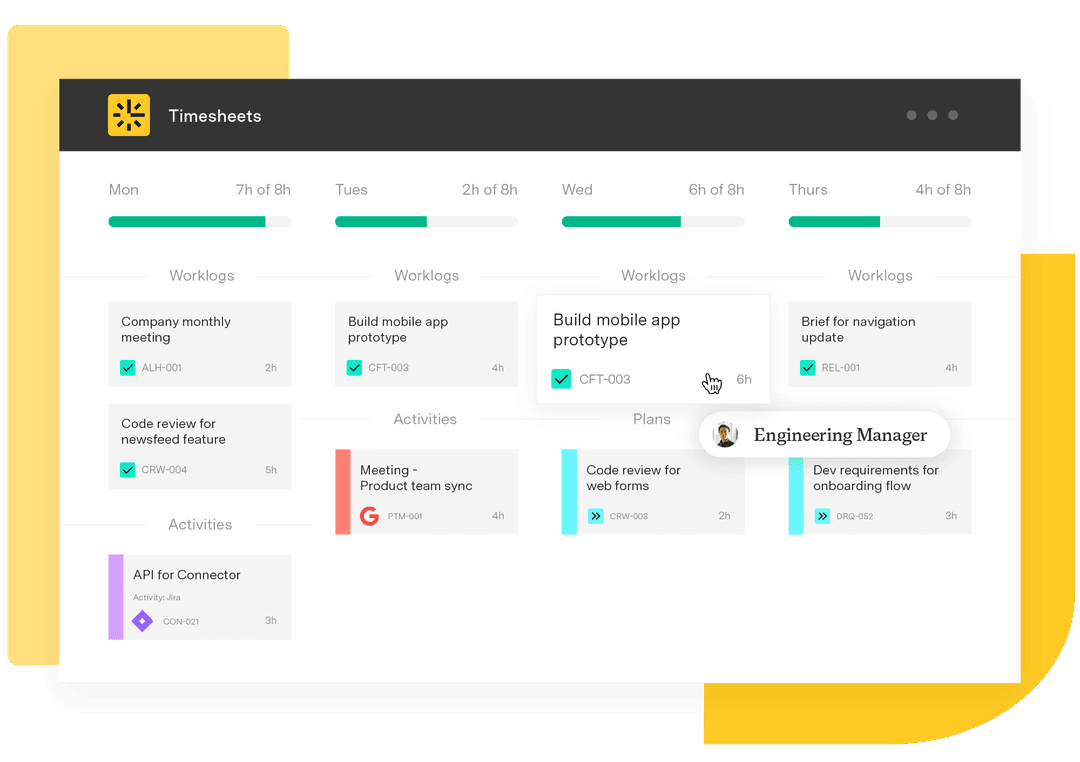Best 10 project post-mortem templates for Jira
Tempo Team
Every project has a story. Some are smooth sailing, with milestones met and deliverables delivered on time. Others are full of twists – unexpected roadblocks or last-minute changes that blow your schedule off course.
Whatever the outcome of the project, you rarely get to tell the full story. Teams move on quickly, leaving behind valuable lessons and opportunities for improvement.
A project post-mortem template helps you capture every detail. In one place, you can review project successes, identify areas for improvement, and turn insights into action.
Let’s explore what a post-mortem is, plus 10 templates to improve your project reviews.
What is a post-mortem meeting?
A post-mortem is a structured way for your project team to look back on a completed project and identify opportunities to improve. A template guides post-mortem meetings, capturing successes and key lessons learned in an objective, productive way.
In these meetings, teams usually walk through the timeline, review deliverables, analyze any incidents, and pinpoint areas of improvement. You can also document action items and create a clear action plan for future projects. This process gives project managers and stakeholders a concise summary of what happened, aligning and informing everyone involved.
When you run structured post-mortems, you turn every project into a learning opportunity and set your team up to achieve better results next time – and every time.
Why use a post-mortem meeting template?
A post-mortem meeting can feel uncomfortable if it isn’t guided. Without structure, these conversations can easily slide into finger-pointing or vague “we’ll do better next time” promises. A project retrospective template or an agile retrospective template changes that. Think of it as a roadmap that keeps the discussion productive and – most importantly – actionable.
Using a good template encourages open feedback and collaboration. A well-designed lessons-learned template strengthens incident management and improves workflows, so your team makes smarter decisions for upcoming projects.
Here’s what makes it so valuable.
Fosters a blameless culture
Post-mortem work best when people feel safe to speak up. A good template keeps the focus on what occurred, not who to blame. Instead of finger-pointing, the team can collaborate and highlight takeaways that move the project forward. That kind of environment encourages honesty and keeps the discussion constructive.
Ensures comprehensive analysis
Big or small, every project leaves behind valuable lessons. A post-mortem meeting template guides the team through a full review – from deliverables to incidents – so nothing gets overlooked. By capturing details in a clear report or even a quick survey, you build a reliable record that project managers and stakeholders can return to later.
Creates actionable insights
Reflection is only useful if it leads to change. A template helps turn raw notes into action items and a concrete action plan. That might mean adjusting how you handle incident response, setting up automated workflows to prevent delays, or simply updating your status page so stakeholders stay informed. Whatever the outcome, you leave the room knowing exactly what to implement next.
Aligns project managers and stakeholders
Ask everyone on the team how the project went, and you’ll probably get different answers. A shared report template or summary evens the playing field. By gathering input through a questionnaire or even a quick survey template, you make sure every participant has a voice. The result is an overview that keeps everyone aligned long after the project’s completion.
Builds continuous improvement into the workflow
When you run post-mortems regularly, they stop being a “nice-to-have” and start becoming a key part of your process. Each retrospective strengthens your approach to project management and sparks ideas for better tools like an OKR template, a Business requirements document template, a creative brief template, custom chart templates, or Agile templates for your next sprint.
What are some post-mortem templates for projects?
A project post-mortem or lessons-learned template is flexible. Different teams and project types call for different approaches. Some teams prefer a quick retrospective that highlights wins and areas of improvement, while others need a deep dive with detailed analysis and a full report template for stakeholders.
Here are 10 practical templates you can adapt to fit your next post-mortem meeting:
1. Start, stop, continue template
Purpose: Quickly identify what to adopt, remove, or continue in future projects.
How to use it: Use a whiteboard or survey template. Each team member adds their thoughts, then discusses and assigns action items to make changes happen.
Template structure:
Start: New practices or tools to implement
Stop: Ineffective habits or blockers
Continue: Processes, behaviors, or tools that worked
Sample prompts:
What slowed us down?
What helped the team succeed?
Which processes could improve efficiency?
2. The 4 Ls template
Purpose: Encourage reflection on successes, gaps, and opportunities.
How to use it: Ask participants to write responses individually, then group similar ideas and highlight key themes. This makes it easier to turn reflections into actionable next steps.
Template structure:
Liked: What we appreciated about the project
Learned: Skills, knowledge, or insights gained
Lacked: Resources, tools, or support that were missing
Longed for: What we wish had happened differently
3. Detailed project timeline review template
Purpose: Track milestones, deviations, and incidents across the project timeline.
How to use it: Walk through the timeline as a team. Capture incidents, delays, and lessons learned. Then, assign owners to implement improvements.
Template table:
Milestone | Planned date | Actual date | Notes on incidents | Action items | Owner |
Deliverable A | June 10 | June 15 | Resource shortage caused a delay | Adjust team allocation | Sarah |
Deliverable B | July 5 | July 5 | On track | None | James |
4. Goals vs. results template
Purpose: Compare project objectives with actual outcomes and highlight gaps.
How to use it: Discuss results as a team. Document lessons learned and create a post-mortem report template for stakeholders.
Goal | Success metric | Actual result | Status | Lessons learned | Action plan |
Launch new feature | Release by Q2 | Released Q3 | Behind | Need better timeline estimates | Add buffer to roadmap |
Improve the onboarding process | 90% satisfaction | 92% satisfaction | On track | Approach worked well | Replicate for other projects |
5. Budget and resource analysis template
Purpose: Review budget use and resource allocation to identify opportunities for improvement.
How to use it: Analyze budget and resource use in the post-mortem meeting. Assign owners to implement the improvement.
Budget item | Planned | Actual | Variance | Notes/causes | Recommendations |
Design | $5,000 | $6,200 | +$1,200 | Unexpected revisions | Include contingency |
Development | $15,000 | $14,500 | -$500 | Efficient workflows | Keep the current approach |
6. Agile sprint retrospective template
Purpose: Keep Agile sprints productive and continuously improving.
How to use it: Conduct this review at the end of each sprint. Collect honest feedback and assign owners to implement changes.
Template structure:
What went well?
What didn’t go well?
What can we try differently?
Owner for each action item:
7. Incident post-mortem template
Purpose: Analyze incidents, learn from them, and prevent recurrence.
How to use it: Capture incidents immediately. Discuss them in the post-mortem meeting and assign action items to improve incident management.
Incident | Date/Time | Impact | Root cause | Response taken | Lessons learned | Action items | Owner |
Server outage | Aug 10, 2 PM | High | Overloaded database | Restarted server, monitored | Improve monitoring | Add automated alerts | Alex |
Data sync error | Aug 12, 10 AM | Medium | Misconfigured workflow | Rolled back changes | Double-check configurations | Create checklist | Priya |
8. Client-facing project review template
Purpose: Communicate project outcomes clearly to clients or stakeholders.
How to use it: Summarize project successes, highlight lessons learned, and assign action items to guide the next engagement.
Template outline:
Project overview and objectives
Key deliverables and completion status
Successes and challenges
Next steps and follow-up plan
9. Risk management assessment template
Purpose: Review project risks and evaluate mitigation strategies.
How to use it: Review risks during the post-mortem meeting. Assign owners to implement mitigation improvements.
Risk | Likelihood | Impact | Mitigation strategy | Actual outcome | Lessons learned | Action items | Owner |
Delayed approval | Medium | High | Weekly check-ins | Delayed by 3 days | Need earlier alignment | Schedule kickoff approvals earlier | Rachel |
Key staff unavailable | Low | Medium | Cross-training | Managed without delay | Good preparation mitigated the impact | Continue cross-training | Tom |
10. Team health and collaboration check template
Purpose: Measure team dynamics, communication, and collaboration.
How to use it: Send a survey template before the post-mortem meeting. Discuss results and assign owners for improvement actions.
Template survey prompts:
Was the workload balanced across the team?
Did communication feel clear and timely?
How effectively did the team collaborate?
What suggestions improve future teamwork?
Improving project outcomes with Tempo
A project post-mortem template becomes far more powerful when paired with objective data. Tempo gives your team exactly that: Insights directly within Jira to make project reviews both reflective and actionable.
Timesheets provide a clear view of how your team spent their time across tasks and projects. You can pinpoint bottlenecks or tasks that took longer than expected. This turns conversations about timeline and deliverables into fact-based discussions that everyone can understand.
With custom charts, you can visualize project progress, highlight project successes, and uncover patterns across multiple projects. These visuals transform post-mortem reports into roadmaps for improvement.
By combining structured post-mortems with Tempo, your team can capture lessons learned and implement changes that drive better outcomes on every project. Try it in Jira today and turn every project into a learning opportunity.












































